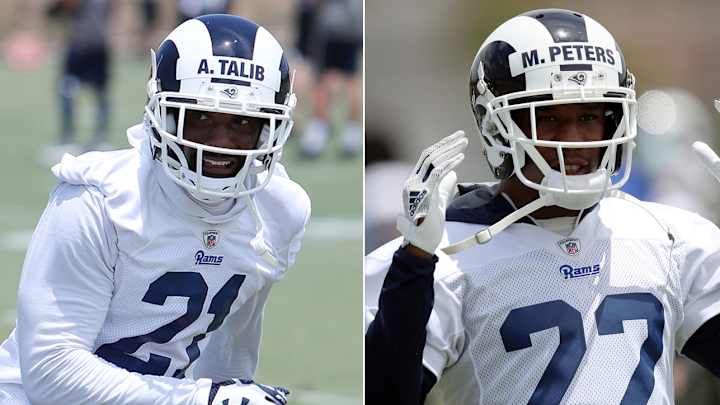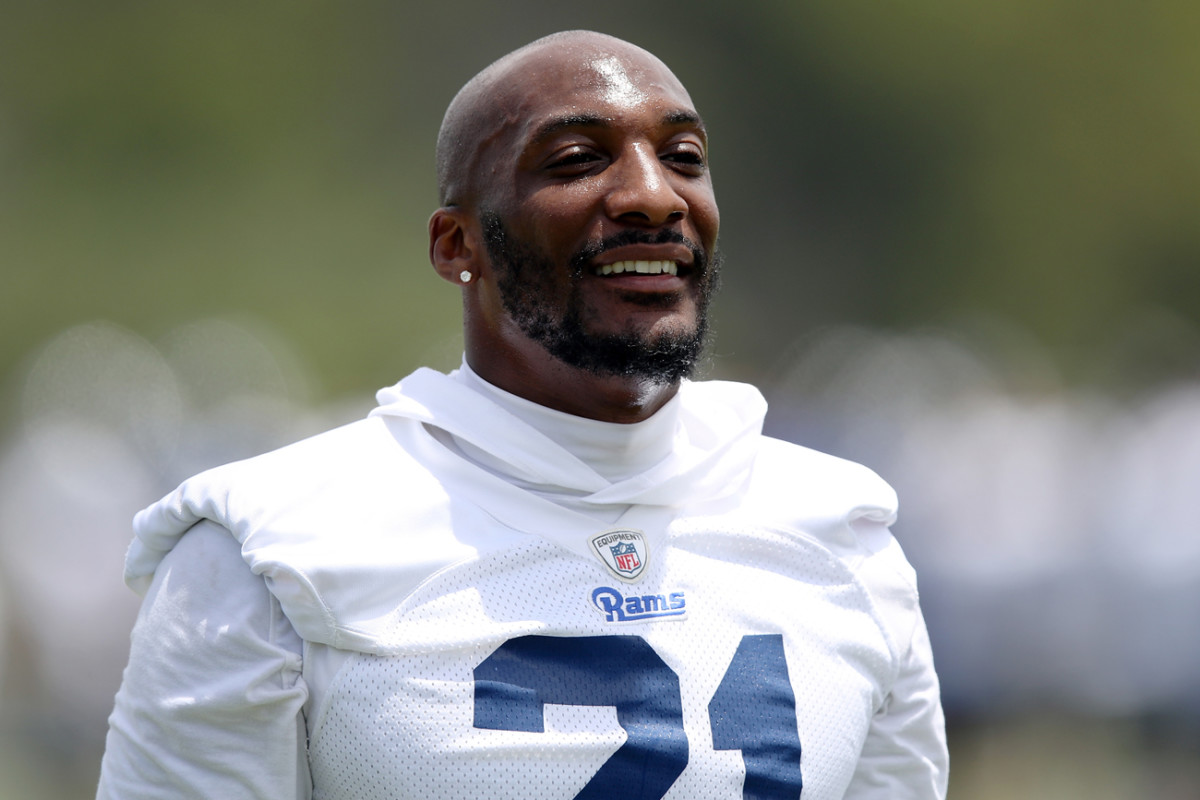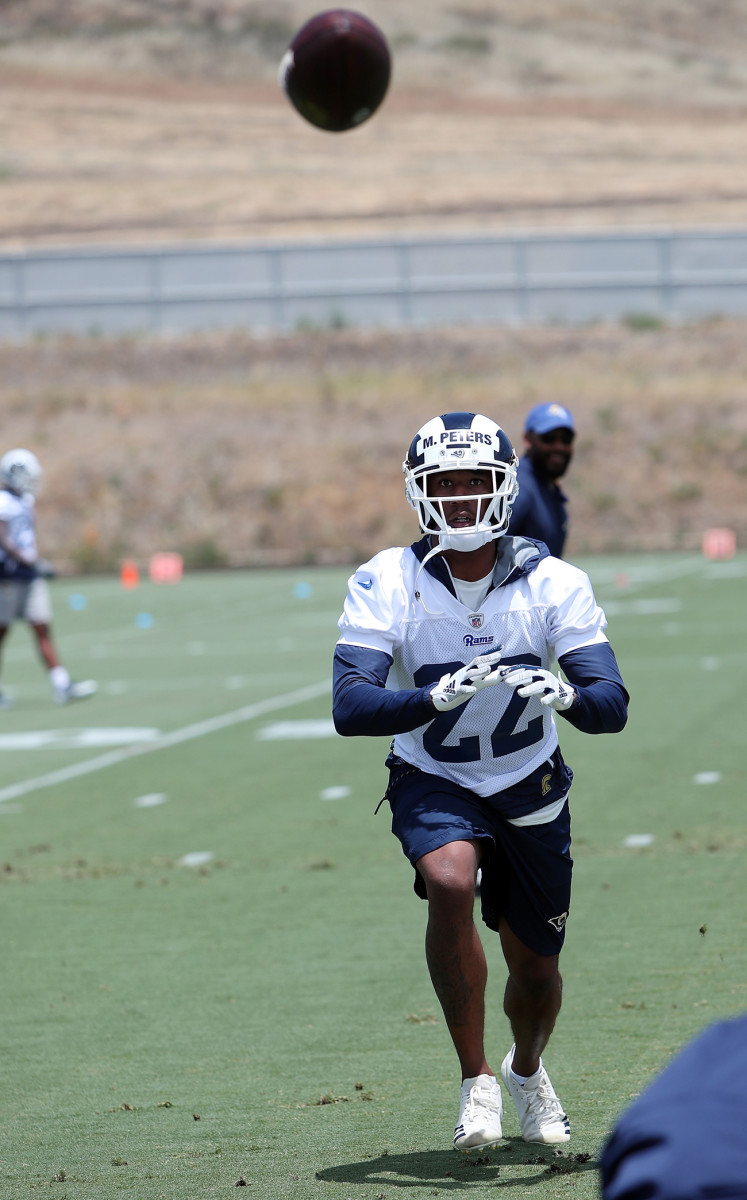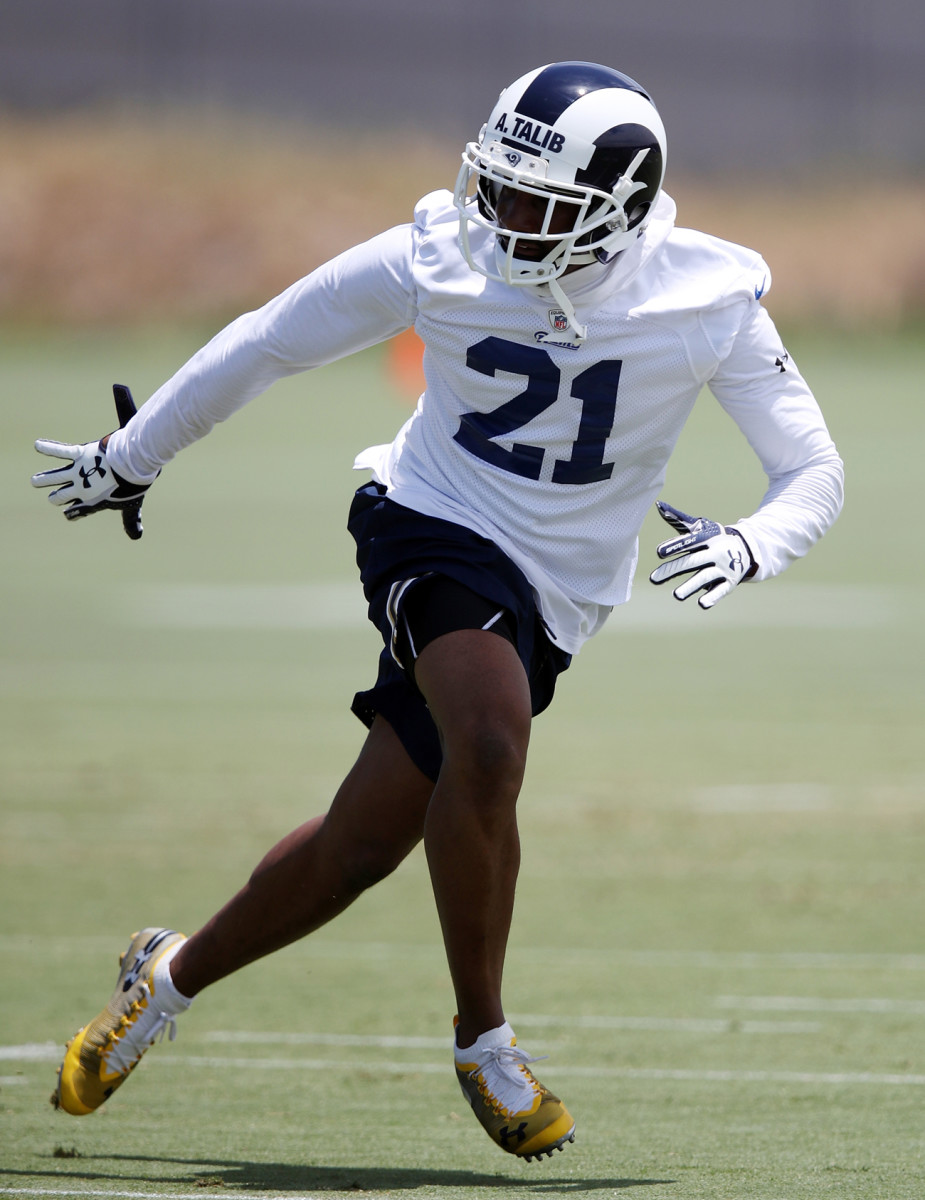Aqib Talib and Marcus Peters: How a Pair of Risk-Taking Corners Could Give the Rams the Edge

The 2018 season is shaping up to be the most anticipated year ever for the NFL in California. The MMQB’s Andy Benoit is diving into the storylines for our special offseason project: California Week. Check back regularly for more.
THOUSAND OAKS, Calif. — After the 2017 season, Aqib Talib got a call from Broncos football czar John Elway: The veteran cornerback, who’d just finished his fourth season in Denver, was being traded to San Francisco. “I told him, ‘I ain’t even gonna take no physical in San Fran, so there won’t be no trade,’ ” Talib says.
Elway asked which teams Talib would play for on his existing contract. (That deal was worth $11 million in 2018 and $8 million in 2019.) There were only three: the Patriots, Cowboys and Rams. This late in his career, Talib craved familiarity.
“I’m going on year 11, man. I’m not trying to go learn a whole new system. I wanted to go somewhere I’d be comfortable.” Talib says this while sitting on the curb of the sidewalk between the Rams’ practice field and parking lot.
The Richardson, Texas, native explained, “I’m comfortable if I can live at my house in Dallas and go just around the corner to work. I cut my bills in half. Or if I can go play in a defensive scheme that I’ve played in before. So I told him Dallas, New England or L.A.”
The Rams, it so happened, had already visited with Elway, and it wasn’t long before Talib got a call from L.A. coach Sean McVay. On March 9, Talib, who has been named to the last five Pro Bowls and was All-Pro in 2016, was dealt to L.A. for a fifth-round pick.

It was just one of four mega moves by the Rams in what has become the most intriguing, aggressive offseason in recent memory. On April 3 L.A. traded the 23rd overall pick to New England for wideout Brandin Cooks. A week earlier, the Rams signed free-agent defensive tackle Ndamukong Suh to a one-year, $14 million deal. And, before trading for Talib, they dealt a 2019 second-round pick and a 2018 fourth-rounder to Kansas City for Pro Bowl cornerback Marcus Peters and a sixth-round pick. Many believe the moves give L.A. a defense capable of matching the big-play aptitude of its vaunted offense.
Talib is a creature of habit. He keeps a meticulous notebook on each week’s upcoming opponent. “I go through first- and second-down plays on Wednesdays. Go through their big personnel—‘21’ [2 running backs, 1 tight end] and ‘12’ [1 back, 2 tight ends]. See what they like to do.
“Usually teams have an [offensive identity], they like to do something. They line up like this, they like to do that. Or they line up like that, and they like to do this.
“Thursday we go through all third downs—third-and-short, third-and-intermediate, third-and-long. Teams tend to do the same thing over and over again if you really watch. They might make it look different, they may dress it up a little.
“Fridays I do the red zone, situational stuff, two-minute. Things like that.”
Sean McVay vs. Kyle Shanahan: The NFL’s Best New Coaching Rivalry
This pattern is standard across the league, but you can’t help but smile at Talib’s enthusiasm as he describes it.
Though still an upper-echelon defender, Talib isn’t even the most dynamic corner Los Angeles traded for this offseason. That’d be Marcus Peters, who is new to Wade Phillips’s scheme and these days is often found sitting next to Talib, asking questions.
Both corners are more matchup-oriented than zone-oriented, but neither has traveled with specific receivers much in recent years. Talib very often played on the left side in Denver. And it was noted constantly that the left side is where Peters played in Kansas City. Many were perplexed that he didn’t shadow No. 1 receivers. Asked how often he heard about this, Peters, sitting in an outdoor lounge near the Rams’ locker room, says, diplomatically but edgily, “Man, I just do what the coaches ask of me.”
Judging from their work this spring, Rams coaches will often ask Peters to play on the right side. He has little concern about the switch. Same goes for Phillips. “We’re a ‘corners over’ defense,” the veteran defensive coordinator explains. “Our corners go with the wide receivers wherever they are. If both are on the left, both corners are on the left. If both on the right, vice-versa. So we haven’t worried too much in the past, because you have to learn to play both sides anyway.” Notably, the Chiefs have also been a “corners over” defense, with Peters taking the slot against two-receiver packages. But you only get this formation a few times a game.

Wherever he is, Peters plays to his help, be it from teammates or the sideline. “It’s training wheels, man. The art of a corner ain’t nothing but training wheels. You’ve got two of them, and you’re in the middle. So it don’t matter what side you’re going to lean to, it’s always going to balance out.”
Still, some players lament flipping sides. It can be a drastic adjustment in technique. In March, Bears guard Josh Sitton put it into context every person can imagine, saying it’s like “trying to wipe your ass with your opposite hand.”
Asked about this, Peters, either deflecting or just plain missing the point, smiles and says, “I don’t know who wipes with their off hand. That’s nasty.”
Talib and Peters knew each other before joining the Rams, though not well. Neither can recall their first encounter.
“I might have first met him when [my Broncos] won the Super Bowl in the Bay,” says Talib. “I think one of those first nights we went out with Marshawn [Lynch, a Bay Area native].”
“Damn, where’d I meet him at,” Peters ponders aloud, resting his chin in his palm. “Probably on the phone. Or sometime before we played Denver. I’ve always been a fan of his.”
Much has been made about the big-play potential of the Rams’ offense, which led the league in scoring last year and has since added a true No. 1 speed receiver in Cooks. That hype will continue; McVay has coveted Cooks for years, and has been even more smitten since seeing him in practice. Receivers like Cooks are precisely why the Rams knew they needed quality corners. Plus, having those corners frees up their scheme.
The NFL’s Most Dynamic Team? 10 Thoughts on the 2018 Rams
“In [Talib’s and Peters’s] case, you can put the pressure on them to take out one receiver,” Phillips says. “That helps so much when you’re trying to design what you want to do. It’s such a matchup league, you know? If you have a guy that can match up, you can design different things on defense to help other areas.”
Whereas before the Rams had a play-stopper in Trumaine Johnson (whom they finally let walk in free agency this offseason), they now have a pair of play-makers. Talib and Peters might rank 1 and 1A in terms of aggressiveness at their position. Their off-coverage, route-jumping style is high-risk, high-reward.
“High risk is high reward,” says Peters flatly. “There’s a select few of us that can do it, to be honest. That’s what makes us so unique.”
Peters is quick to cite the value of the defensive backs coaches he has worked with since high school—listing each by name—and is grateful that all of his coaches told him “to just be Marcus. They never told me to change nothing about my game. We just want you to go out and be yourself.”
It takes a certain level of humility—even courage?—for a coach tell Peters this. Because the 25-year-old corner won’t just take chances—he’ll sometimes deviate completely from a designed coverage. A perfect example was his interception last year in Week 3 at the L.A. Chargers.
“I know exactly what you’re talking about,” he says quickly at mention of the play. You’ll sometimes see a corner improvise and convert zone coverage into man coverage. But on that play, Peters did the opposite, converting man coverage into zone. It’s almost unheard of, since going zone on your own means letting your assigned receiver run free. “Can’t too many of us do it,” he says.
It wasn’t done on a whim. “Philip Rivers doesn’t like throwing that route against me,” Peters explains, elaborating on how the intended target, veteran tight end Antonio Gates, relies more on body positioning than speed these days. It was this knowledge that inspired Peters to go rogue and attack the ball.
Some of Talib’s coverage decisions can be perilous as well, but as with Peters, his gambles tend to be premeditated. “If we’re in Cover 8 [a form of two-deep zone] and I get a certain look? That’s a play for me,” Talib says. “If we’re in Cover 1 [man-to-man], that’s a catch and tackle. I ain’t really trying to do too much. So I figure out where my opportunities are, on what looks.”
The NFL in California in 2018: The Best Year Ever?
Many corners study tendencies based on a wide receiver’s split—in other words, how far out the receiver is aligned. “But I think nowadays teams do a good job of running a lot of stuff from the same splits or just switching up their splits consistently,” Talib says. “It’s not like back in the day when somebody would line up at the bottom of the field numbers and run the Bang-8 [skinny post] every time. My rookie year that’s how it was—it was clockwork, every time.
“Now, it’s a new age of football. Splits are not as specific as back in the day. It’s more the receivers themselves now. The deep guys, the intermediate guys, the reverse screen guys. You just got to know the body that you’re covering and have a good idea of what you’re going to get.” Talib then goes into elaborate details on the various things you get based on personnel packages and situations. This is the lens through which he studies opponents.

You get the sense that his favorite moments are in hurry-up situations. “It’s like playing Nintendo,” he says. “Remember in Nintendo when you were hurrying you’d always go to the same playbook? NFL offenses are the same way.”
This line of thinking will make the Rams a fascinating defense in 2018. Corners who play tendencies and attack routes are lethal when they’re behind a dominant pass rush that can force quarterbacks to throw on the defense’s schedule. But if the pass rush doesn’t get home, these same corners become susceptible to double moves and late breakdowns in technique. We’ve seen this throughout Peters’s and Talib’s careers. The Rams may have the league’s best interior rush with newcomer Ndamukong Suh and especially Aaron Donald, but they’re thin and unproven on the edges.
Jimmy Garoppolo Takes Charge, Richard Sherman Steps In: 10 Thoughts on the 49ers
Phillips isn’t worried. “The rush helps the coverage, the coverage helps the rush, you know? Chicken or the egg sometimes. But we had 48 sacks last year, so we feel like we’re going to have a good rush. And then when you’ve got guys of that caliber [on the corners], it will help us not only in the coverage but maybe turnovers too. That’s what we’re looking for.”
Question or comment? Email us at talkback@themmqb.com.
Read more about the Super Bowl
manual
